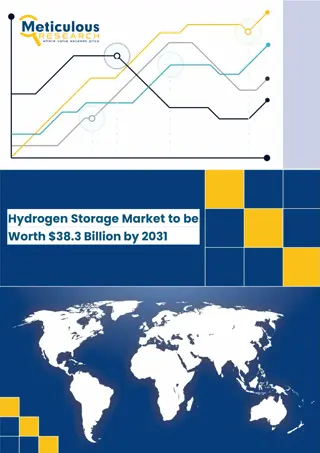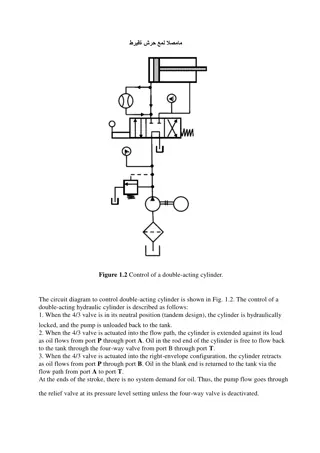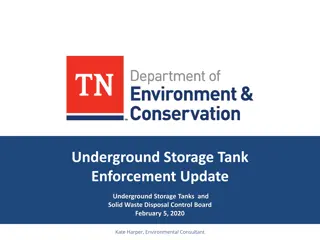Water Storage Tanks Hydraulic Modeling and Water Quality Considerations
This presentation by Justine Carroll, P.E., Project Manager, focuses on the hydraulic modeling and water quality considerations related to water storage tanks. It covers topics such as water age evaluation, steady state modeling, extended period simulations, pump controls, demand patterns, EPS verification, water quality modeling, and water age issues in the system. The content emphasizes the importance of assessing and improving various aspects of water systems to ensure water quality and operational efficiency.
Download Presentation

Please find below an Image/Link to download the presentation.
The content on the website is provided AS IS for your information and personal use only. It may not be sold, licensed, or shared on other websites without obtaining consent from the author. Download presentation by click this link. If you encounter any issues during the download, it is possible that the publisher has removed the file from their server.
E N D
Presentation Transcript
Water Storage Tanks Hydraulic Modeling and Water Quality Considerations Justine Carroll, P.E. Project Manager
Outline Water age evaluation using EPS Tank mixing and turnover Case Study Maple Street Tank, Paxton
Hydraulic Modeling
Steady State Pipe, tank, pump data used in model Demands distributed to reflect usage Verified using flow testing results Steady state models used for the following: Identify pressure and fire flow deficiencies Evaluate proposed sub-divisions Evaluate hydraulic improvements
Extended Period Simulations Account for changes over time to operational conditions and demand variations Used for the following: Refine recommendations Simulate water quality Improve planning and operation
Pump Controls Pump Water Level Pump On (ft) Water Level Pump Off (ft) Pump No. 1 30 40 Pump No. 2 27 37 Pump No. 3 20 30 Pump Time Pump On Time Pump Off Well No. 1 7:00 am 10:00 am Well No. 2 7:00 pm 7:00 am
Demand Patterns 3.5 3 2.5 Multiplier 2 Residential Commercial 1.5 Hospital 1 School 0.5 0 0 6 12 18 24 Hours
EPS Verification 80 78 Field Data 76 Model Data 74 Water Level (ft) 72 70 68 66 64 62 60 0 3 6 9 12 15 18 21 24 Time (hr)
Water Quality Modeling Constituent Tracking Tracks contamination from a particular source Predicts areas of influence and affected customers Chlorine Levels Predicts chlorine levels in distribution system Considers decay rate from source water and decay from pipe walls
Water Age Time spent in the system Source water age is zero Older water can lead to water quality problems Causes of high water ages include the following: Low demands System extremities Water storage tanks
Tank Mixing and Turnover
Tank Mixing Tank geometry Inlet diameter Inlet/outlet location Water temperature Fill rate Without proper mixing tank can experience short circuiting or stratification
Improving Tank Mixing Changing size of inlet pipe Separating inlet/outlet Mixing system Increasing operational range
Tank Operating Parameters Maintain minimum working pressure 35 psi Maintain minimum pressure of 20 psi during fire Maintain normal working pressures 60-80 psi Maximum pressure without PRVs of 100 psi 3-5 day turnover rate (20 to 30% volume per day) High and low variation less than 30 feet
Tank Turnover Turnover rate depends on operating range and demands 0.5 mg tank, 50 ft high, 40 ft diameter 5 ft operating range = 10% turnover 10 ft operating range = 20% turnover
Case Study: Maple Street Tank Paxton, MA
Paxton, Massachusetts Average Daily Demand - 0.3 mgd Maximum Daily Demand - 0.7 mgd Population Served 3,680 All water purchased from Worcester 33 miles of main Total Storage - 1.36 mg (two tanks)
Asnebumskit Tank Constructed in 1974 Prestressed Concrete Tank Height 40 feet Diameter 65 feet Volume 1.0 mg
Existing Maple Street Tank Constructed in 1934 Welded steel Height 100 feet Diameter 25 feet Volume 0.36 mg Rehab costs - $300,000
Maple Street Tank Deficiencies Unusable storage High water age Low chlorine residual Repairs
Current Estimated Water Age 900 800 700 Water Age (hr) 600 Asnebumskit Tank 500 Maple Street Tank 400 300 200 100 0 0 48 96 144 192 240
Chlorine Performed jar tests at pump station Took 14 chlorine samples at 12 locations 0.5 mg/L residual from Asnebumskit Tank 0.05 mg/L residual from Maple Street Tank
Recommendations and Benefits Smaller elevated storage tank Provides fire protection Redundant storage location Maintains pressures Reduces water age More useful water storage
Proposed Maple Street Tank Glass fused steel Tank height 38 feet Total height 100 feet Volume 0.20 mg Chlorine booster pump Active mixing system Same site as existing tank
Maple Street Tank Water Age 900 800 700 Water Age (hr) 600 Existing Tank 500 Proposed Tank 400 300 200 100 0 0 48 96 144 192 240
Schedule Design/permitting Ongoing MassDEP filing/review October 2014 Advertising November 2014 Award contract January 2015 Construction Spring to Fall 2015 Tank demolition December 2015
Questions? contact@tataandhoward.co m 800-366-5760























